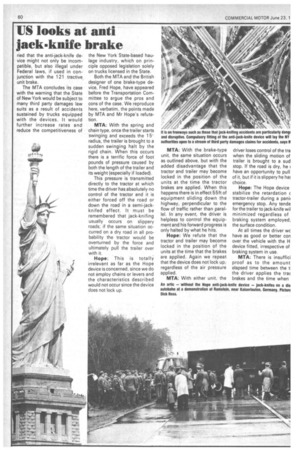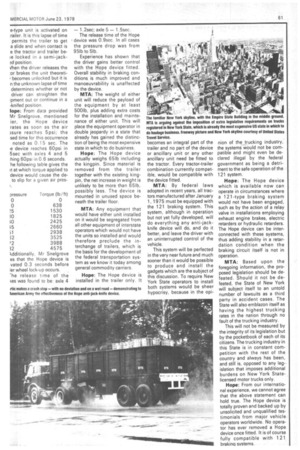US looks at anti jack-knife brake
Page 62

Page 63

If you've noticed an error in this article please click here to report it so we can fix it.
ried that the anti-jack-knife device might not only be incompatible, but also illegal under Federal laws, if used in conjunction with the 121 tractive unit brake.
The MTA concludes its case with the warning that the State of New York would be subject to many third party damages law suits as a result of accidents sustained by trucks equipped with the devices. It would further increase rates and reduce the competitiveness of the New York State-based haulage industry, which on principle opposed legislation solely on trucks licensed in the State.
Both the MTA and the British designer of one brake-type device, Fred Hope, have appeared before the Transportation Committee to argue the pros and cons of the case. We reproduce here, verbatim, the points made by MTA and Mr Hope's refutation.
MTA: With the spring and chain type, once the trailer starts swinging and exceeds the 15' radius, the trailer is brought to a sudden swinging halt by the rigid chain. When this occurs there is a terrific force of foot pounds of pressure caused by both the length of the trailer and its weight (especially if loaded).
This pressure is transmitted directly to the tractor at which time the driver has absolutely no control of the tractor and it is either forced off the road or down the road in a semi-jackknifed effect. It must be remembered that jack-knifing usually occurs on slippery roads; if the same situation occurred on a dry road in all probability the tractor would be overturned by the force and ultimately pull the trailer over with it.
Hope: This is totally irrelevant as far as the Hope device is concerned, since we do not employ chains or levers and the characteristics described would not occur since the device does not lock up. MTA: With the brake-type unit, the same situation occurs as outlined above, but with the added disadvantage that the tractor and trailer may become locked in the position of the units at the time the tractor brakes are applied. When this happens there is in effect 55ft of equipment sliding down the highway, perpendicular to the flow of traffic rather than parallel. In any event, the driver is helpless to control the equipment and his forward progress is only halted by what he hits.
Hope: We refute that the tractor and trailer may become locked in the position of the units at the time that the brakes are applied. Again we repeat that the device does not lock up; regardless of the air pressure applied.
MTA: With either unit, the driver loses control of the tra when the sliding motion of trailer is brought to a sud stop. If the road is dry, he have an opportunity to pull of it, but if it is slippery he ha: choice.
Hope: The Hope device stabilize the retardation c tractor-trailer during a panii emergency stop. Any tende for the trailer to jack-knife wil minimized regardless of braking system employed, the surface condition.
At all times the driver we have as good or better con over the vehicle with the K device fitted, irrespective of braking system in use.
MIA: There is insuffici proof as to the amount elapsed time between the ti the driver applies the trac brakes and the time when e-type unit is activated on :railer. It is this lapse of time permits the trailer to get a slide and when contact is e the tractor and trailer bele locked in a semi-jackAposition.
klhen the driver releases the or brakes the unit theoreti, becomes unlocked but it is tithe unknown lapse of time determines whether or not driver can straighten the ipment out or continue in a -knifed position.
lope: From data provided Mr Snelgrove, mentioned ier, the Hope device rates as soon as the air ;sure reaches 5psi; the ,sed time for this occurrence
noted as 0.15 sec. The ie device reaches 60psi in 5sec with axles 4 and 5 :hing 60psi in 0.6 seconds. lte following table gives the it at which torque applied to device would cause the deto slip for a given air pres es that the Hope device is vated 0.3 seconds before ler wheel lock-up occurs.
he release time of the The release time of the Hope device was 0.9sec. In all cases the pressure drop was from 95Ib to 51b. Experience has shown that the driver gains better control with the Hope device fitted. Overall stability in braking conditions is much improved and manoeuvrability is unaffected by the device. MTA: The weight of either unit will reduce the payload of the equipment by at least 500lb, plus adding extra costs for the installation and maintenance of either unit. This will place the equipment operator in double jeopardy in a state that already has gained the distinction of being the most expensive state in which to do business. Hope: The Hope device actually weighs 65Ib including the kingpin. Since material is removed from the trailer together with the existing kingpin, the net increase in weight is unlikely to be more than 651b, possibly less. The device is mounted in unused space beneath the trailer floor. MTA: Any equipment that would have either unit installed on it would be segregated from all other equipment of interstate operators which would not have the units so installed and would therefore preclude the interchange of trailers, which is the basis for the development of the federal transportation system as we know it today among general commodity carriers. Hope: The Hope device is installed in the trailer only. It becomes an integral part of the trailer and no part of the device or ancillary unit or any other ancillary unit need be fitted to the tractor. Every tractor-trailer combination currently compatible, would be compatible with the device fitted. MTA: By federal laws adopted in recent years, all tractors manufactured after January 1, 1975 must be equipped with the 121 braking system. This system, although in operation but not yet fully developed, will do everything any anti-jackknife device will do, and do it better, and leave the driver with an uninterrupted control of the vehicle. This system will be perfected in the very near future and much sooner than it would be possible to produce and install the gadgets which are the subject of this discussion. To require New York State operators to install both systems would be sheer hypocrisy, because in the opi nion of the trucking industry, the systems would not be compatible and might even be declared illegal by the federal government as being a detriment to the safe operation of the 121 system. Hope: The Hope device which is available now can operate in circumstances where a 121-type braking system would not have been engaged, such as by the action of a relay valve in installations employing exhaust engine brakes, electric retarders or hydraulic retarders. The Hope device can be interconnected with these systems, thus adding stability in a retardation condition when the braking circuit itself is not in operation. MTA: Based upon the foregoing information, the pro posed legislation should be de feated. Should it not be defeated, the State of New York will subject itself to an untold number of lawsuits as a third party in accident cases. The State will also emblazon itself as having the highest trucking rates in the nation through no fault of the trucking industry. This will not be measured by the integrity of its legislation but by the pocketbook of each of its citizens. The trucking industry in this State is in constant com petition with the rest of the country and always has been, and still is, opposed to any legislation that imposes additional burdens on New York Statelicensed motor trucks only. Hope: From our international experience, we cannot agree that the above statement can hold true. The Hope device is totally proven and backed up by unsolicited and unqualified tes timonials from major vehicle operators worldwide. No operator has ever removed a Hope device once fitted. It is of course fully compatible with 121 brakino systems.




































































































































































